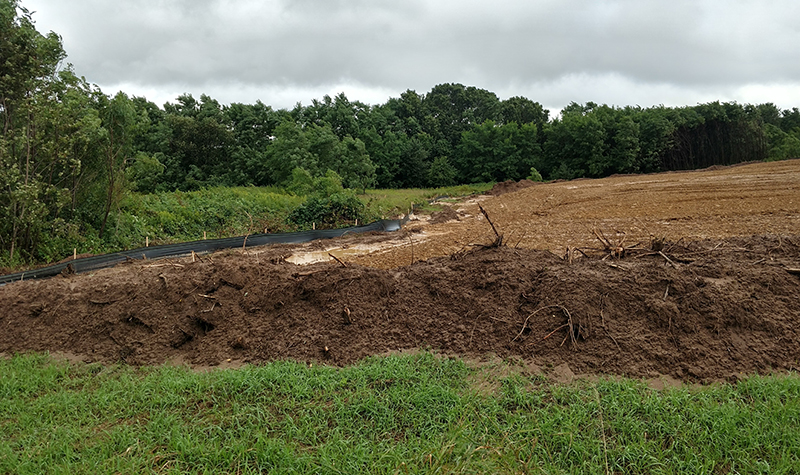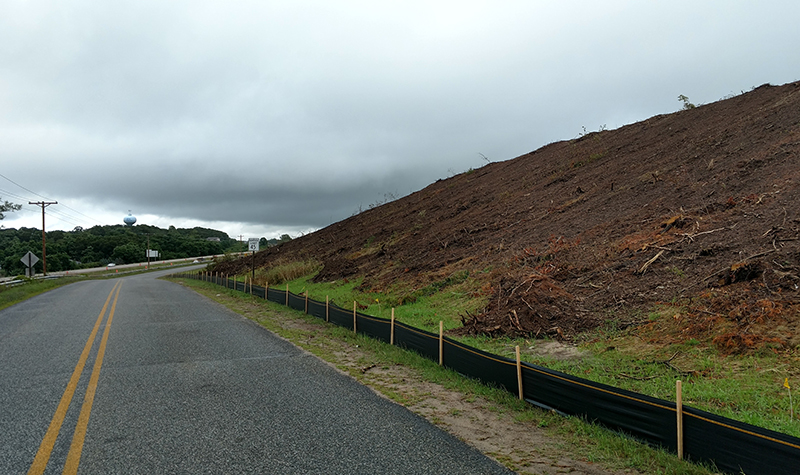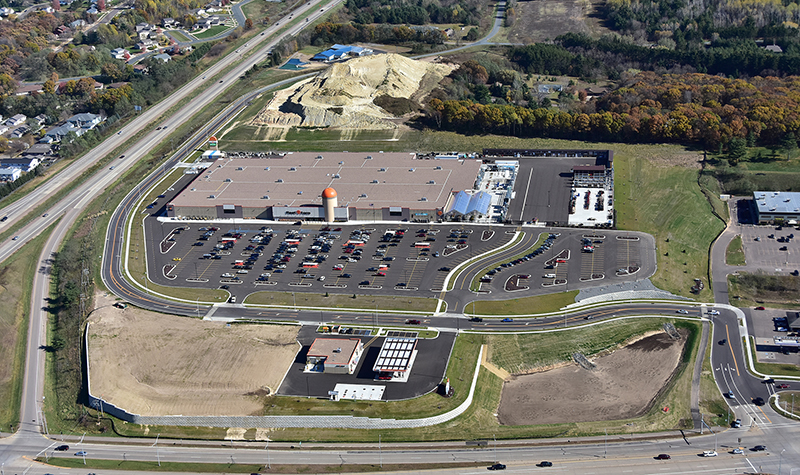Piecing Projects Together: Permit Puzzle Lays Foundation for Site Development
Wherever you go, chances are you’ll encounter some kind of construction project, whether it be minor road repairs on your commute or a major undertaking to prepare a site for a big-box store.
What you see isn’t always what you get – by the time you drive by and see that hole in the ground or that mountain of excavated earth, a lot of work has already happened. It’s through civil engineers’ careful calculations that major developments can happen, and their work starts long before any dirt is moved. It can take years before the doors open to your community’s newest restaurant or office building.
Consider the transformation of a vacant Interstate highway quadrant into a Fleet Farm store and gas station/car wash facility. It was a challenging project, not only because of the quick design timeline (13 months from the start of design to the grand opening) but also because of the site itself: a steeply sloped hillside along Interstate 94 and STH 93 on the south side of Eau Claire, Wisconsin.
The site required moving approximately 810,000 cubic yards of material, more than half of which was used as fill to grade the approximately 30-acre building site. Drainage was also a challenge, limited by the capacity of an existing storm sewer pipe crossing from the Fleet Farm side of STH 93 to a regional stormwater pond on the other side of the highway.
All of this required a dizzying array of analysis, approvals, and permits before work could start or progress. Permits guide – and sometimes change – project designs, making sure they’re a good fit with the environment, surrounding infrastructure, and community.

Every state has different regulations, and every project is subject to different permitting needs. However, several factors help ease the permitting process.
- Start early. Contact the regulatory agency early in the project’s development to discuss and work through any issues while they’re easy to fix.
- Understand who does what. For example, most projects that affect wetlands or surface waters require working with federal (U.S. Army Corps of Engineers), state, and potentially local permit agencies. Check with each agency at the beginning of the project to confirm their involvement.
- Understand the process. Providing correct and complete information the first time helps keep the review process moving forward.
- Know the people. While permit applications are standardized, there still are personal preferences of each reviewer that should be understood and addressed.
- Allow sufficient time for agency review. And if the schedule is compressed, keep in close contact with the regulators to avoid delays.
For the Eau Claire Fleet Farm project, permits were required from various entities, including the City.
Ayres’ site development professionals coordinated the following to make the Fleet Farm project go from vision to reality:
- Karner Blue butterfly high potential area screening
- Wetland determination
- Wisconsin Department of Natural Resources (WDNR) Stormwater Management Plan and Construction Permit for Erosion Control during Site Grading (pre-development)
- WDNR Stormwater Management Plan and Post-Construction Permit for developed site
- Wisconsin Department of Transportation Work in Right-of-Way Permit
The site already had an existing Non-Metallic Mining Permit and a Stormwater Permit with the WDNR and an existing Non-Metallic Mining Permit with Eau Claire County.
Because the proposed Fleet Farm site didn’t start within City of Eau Claire limits, additional hurdles had to be cleared before construction could begin. City of Eau Claire permits and approvals included:
- Annexation from Town of Washington to City of Eau Claire
- Rezoning and general development plan as part of annexation
- Certified Survey Map (CSM) to relocate right-of-way and subdivide parcel into development lots
- Site plan submittal
- Traffic impact analysis (TIA) as part of site plan review
- Developer’s agreement as part of site plan review
- Grading and drainage plan approval as part of site plan review
- City/Department of Safety and Professional Services (DSPS) plumbing plan approval
- Regional Planning Sewer Service in an Environmentally Sensitive Area – Slopes in Excess of 20 Percent
The City of Eau Claire Engineering Department completed the street, stormwater, and utility design and bidding based on Ayres Associates’ preliminary street and utility design. That included additional planning and coordination, including bringing a water main under Interstate 94 to make the site feasible to construct due to water pressure demand. This required significant coordination with City engineering staff and resulted in a separate contract. In many cases, separate contractors were hired to do the construction on the site other than those who were working on the same pieces within the City right-of-way.

Permits. Approvals. Analysis. Coordination. While these are perhaps not the most exciting aspects of major site developments, they’re integral to the process of bringing a client’s plan to fruition. Navigating the complex web of requirements is made easier when experts are involved right from the start to see that no site development detail gets overlooked.
Gareth Shambeau provides analysis and design on a range of municipal, site/civil, and water resources projects. His responsibilities include preparing plans, specifications, and bidding documents; preparing permit applications and stormwater management plans; performing construction observation; performing CADD; and completing studies, modeling, reports, letters, and cost estimates. He also works with clients, regulatory agencies, and construction contractors.


 By
By
Post a comment: